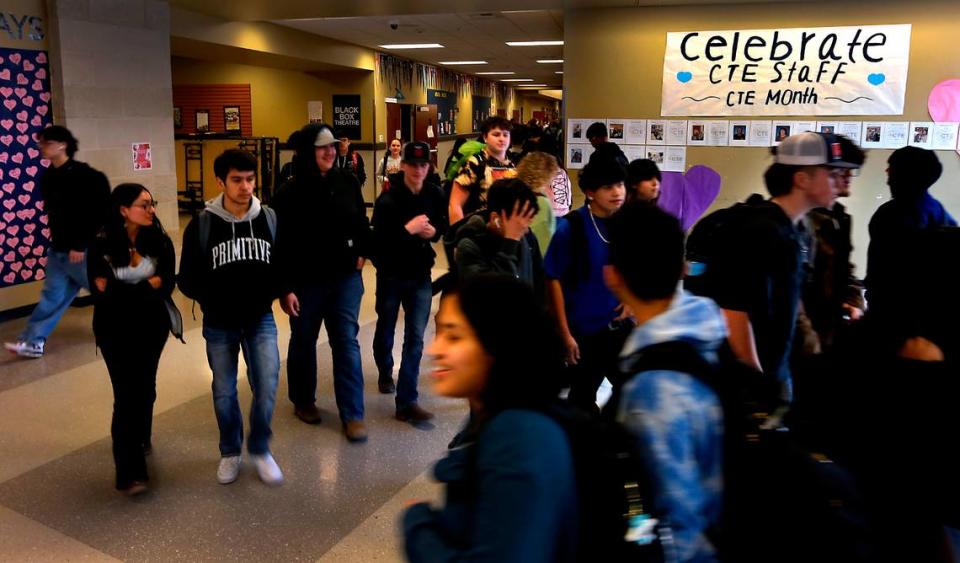Did Tri-Cities schools really manage to dodge COVID’s fiscal bullet? Here’s what we found
Public school districts in the Tri-Cities appear to have dodged a widespread “blood letting” of teacher and staff layoffs thanks to a mix of smart fiscal strategies.
Local districts have slowly been curbing spending, cutting positions by way of staff turnover and retirements, and reorganizing classrooms in the years since COVID decimated student enrollment.
Southeast Washington districts also received hundreds of thousands of dollars in one-time federal pandemic relief money, known as Elementary and Secondary School Emergency Relief (ESSER), and took to heart cautionary warnings about using those for recurring expenses.
“Those districts that saw the budget cliff coming and prepared for it earlier have come out much better this year than some who simply waited or hoped the Legislature would bail us out,” said Kiona-Benton City School District Superintendent Pete Peterson.
His administration caught flack from community members last year after the school board approved a plan to cut the positions of two popular administrators and four vacant teaching positions. The decision saved about $650,000 in a $24 million budget that serves 1,400 majority low-income students in the lower Yakima Valley.
While difficult to swallow, those decisions helped course correct the district and put their schools on stronger financial footing. Their budget for the upcoming 2024-25 school year is looking promising, with a healthy reserve and no cuts expected.
“I think people assumed that the kids they lost during COVID would come back, and so they budgeted that and banked on their budgets necessitating that,” Peterson said.
“If a district believed they could do business exactly the same as before COVID, that was just a very poor assumption because everything changed,” he continued. “The number of students dropped, meaning your revenue was dropping. And at the same time some costs that we usually thought were fixed started going up exponentially.”
Tri-City school districts were growing at a slow, but steady pace prior to the COVID pandemic, and they didn’t experience such stark enrollment dips as other districts saw when schools across the state switched to remote learning.
A gruesome budget year
It’s been a particularly gruesome year for school district budgeting throughout Washington state, with thousands of teachers and supportive staff expected to not return for the 2024-25 school year.
While substantial budget cuts are often context-specific to each school district, many say they’ve struggled with a loss of state funding caused by precipitous drops in enrollment.
Many said they also dealt with a “spending cliff” caused by ESSER, declining birth rates, and rising costs for materials, supplies and operations.
Moses Lake School District plans to lay off about 188 certificated teachers and classified staff for next school year due to a levy failure and accounting issue that forced them to slash more than $20 million in expenditures.
Earlier this year, Yakima School District approved a plan aimed at cutting 138 employees as part of a larger plan to cut costs following years of declining student enrollment.
Some districts are even going so far as to close schools due to declining enrollment. Wenatchee School District plans to close one of its seven elementary schools, while Seattle Public Schools — the state’s largest district — announced plans to possibly shutter the doors to a quarter of its elementary schools.
Although Tri-City schools have avoided such sweeping layoffs and closures, many districts have tightened their pocket books in recent years with concerns percolating over the future of public education funding.
For the 2024-25 school year, it’s estimated Tri-City schools will cut at least three dozen positions through attrition. Most of those are certified teaching positions.
That’s 28 positions in Kennewick schools, and at least five in Pasco. Richland meanwhile is still studying its budget.
“We’re being careful and cautious and as efficient as we can,” said Kevin Hebdon, Pasco School District’s executive director of fiscal services, who credits their successes with strictly adjusting staffing based on enrollment trends and projections.
Clinton Sherman, executive director of financial services at Richland School District, said the ESSER dropoff was a wake up call for struggling school districts in the decade since the McCleary Decision, Washington’s landmark state Supreme Court case that determined public education was not being properly funded.
In response, the state Legislature pumped billions of dollars into local school districts in a series of corrections. In 2018, after being fined $100,000 a day for four years, the state came into compliance with the Supreme Court. But critics argue the reforms have done little to correct systemic funding gaps still seen in schools across the state.
Many are also voicing concern that the state is losing its focus on funding public education — the “paramount duty of the state,” per the Washington constitution — as the percent of the state budget dedicated to funding K-12 education dips below 50%.
“Every district is now realizing that the outcomes from McCleary to fully fund basic education – even though the formulas make sense, the factors within those formulas aren’t high enough to fully fund education,” Sherman said.
What the Tri-Cities got right
Steve McCullough is superintendent at Educational Service District 123, a regional education organization supporting the work of local districts — from Clarkston to Prosser — in Southeast Washington.
He says school districts are contending with several issues affecting their budgets, including declining birth rates, inflation and cost increases, enrollments that have either plateaued or declined, and an exodus of families who chose to enroll their students in private schools or home school.
Why aren’t those variables impacting Tri-City schools as much? McCullough says it’s several things.
“One thing about this region that is a huge strength of school districts is you have relatively stable superintendents across the region that have been in their positions for several years. They are very close, collegially, and they talk to each other about these types of things,” he said. “No one is out on an island trying to do things by themselves.”
An example of that collaboration working was around ESSER spending and the responsible spending of those dollars. Peterson, the school superintendent at Ki-Be School District, credits ESD 123 and the state for coming onto the scene early and warning districts not to hire teachers with ESSER.
McCullough said enrollment in Southeast Washington has also “stayed relatively stable” since COVID, unlike what is being seen in other region’s across the state.
“There’s a lot of people that are looking at this issue right now. And we’re hopeful the Legislature will come up with some solutions that will help districts be more financially stable, because that’s where a lot of the change needs to happen,” McCullough said.
Tri-Cities enrollment still down after COVID
Enrollment is important because it’s tied directly to public education funding. For every one full-time pupil sitting at a desk, schools receive tens of thousands of dollars in general education apportionment from the state.
Districts also receive funds from other sources, such as the federal government, local taxpayers and from fees and other programs. But that enrollment apportionment makes up a large chunk of the total revenue that local school districts receive to operate.
The Tri-City’s “big 3” school districts — Kennewick, Pasco and Richland — oversee the education of more than 50,000 K-12 students.
Comparing enrollments of November 2019 to November 2023, Tri-City schools are still down about 360 full-time students. That’s roughly $3.6 million in revenues missing from those three school districts’ budgets.
Pasco remains down by about 270 full-time students and Kennewick is down by 109 full-time students. Meanwhile, Richland’s enrollment has rebounded to pre-pandemic levels and is in excess of 18 full-time students.
At the same time, higher costs for goods, services and salaries has tampered spending at many districts in the Tri-Cities and around the region.
“Our insurance costs in some districts have gone up 30-60% a year for the past two or three years. It’s unsustainable,” McCullough said.
ESSER and pandemic stimulus money
ESSER is the pandemic-era financial stimulus passed by Congress in 2020 and 2021.
The fund has provided $200 billion for state programs and local school districts, ever since classes were disrupted by the historic COVID pandemic. It’s the largest one-time federal investment in the country’s history.
The third and final installment of these one-time funds must be obligated or spent by Sept. 30. That deadline has left reliant school districts having to make steep classroom cuts for the upcoming school year.
A recent analysis of job postings in Washington state over the last few years by the Center for Analysis of Longitudinal Data in Education Research (CALDER) at the American Institutes for Research suggests an excess of about 12,000 new staff, including 5,100 teachers, were likely hired in Washington due to ESSER.
“We find strong, arguably causal, evidence that public school hiring increased in response to the availability of ESSER funding. Specifically, we estimate that each $1,000 in ESSER allocations caused districts to seek to hire $206 in additional staff, disproportionately teachers,” the analysis reads.
Richland, Kennewick and Pasco each spent their combined portion of $137 million a bit differently, although a majority went to responding to the COVID pandemic in the early weeks, covering the salaries of existing teachers, technology and building upgrades, and addressing learning loss.
“A lot of our districts did not use ESSER dollars to help fund positions, or if they did, they were very clear about how they did that and made sure they reduced those positions when the money went away,” McCullough.
Kennewick School District is an example of a district that did use COVID money to cover salaries, but only for a niche reason.
A double levy failure in 2022 left Kennewick with no levy — and no state match — to collect in 2023, so staff plugged a $34 million hole with COVID relief money, budget cuts and reserves.
The district anticipates it used one-third of its ESSER — about $20 million of its total $59 million allotment — to cover expenses, including teacher salaries, that had been covered by local taxpayers. But Kennewick began collecting its local levy this year.
The CALDER analysis suggests Tri-City schools may have sought to hire more than $28 million in new staff with COVID money over the last three years, which would be equivalent to hundreds additional teachers. But no budgetary evidence has been presented to prove that estimate factual.
Dan Goldhaber, CALDER’s director, told the Tri-City Herald that there’s not much evidence to suggest that school districts hire “better” teachers when there is an oversupply of teaching professionals in the labor market.
“In Washington, during the Great Recession, there were about 10-times as many layoff notices as there were actually layoffs,” he said. “Getting a layoff notice itself causes churn, which is no surprise. If you get a layoff notice, you’re probably looking around to see if you can get a different job, where my job is not as threatened.”
The productivity of teachers in the classroom also takes a hit when layoff notices are given, Goldhaber argues.
“I’d be shocked if we didn’t see a (looser) labor market in the coming years,” he said in response to Washington layoffs.



